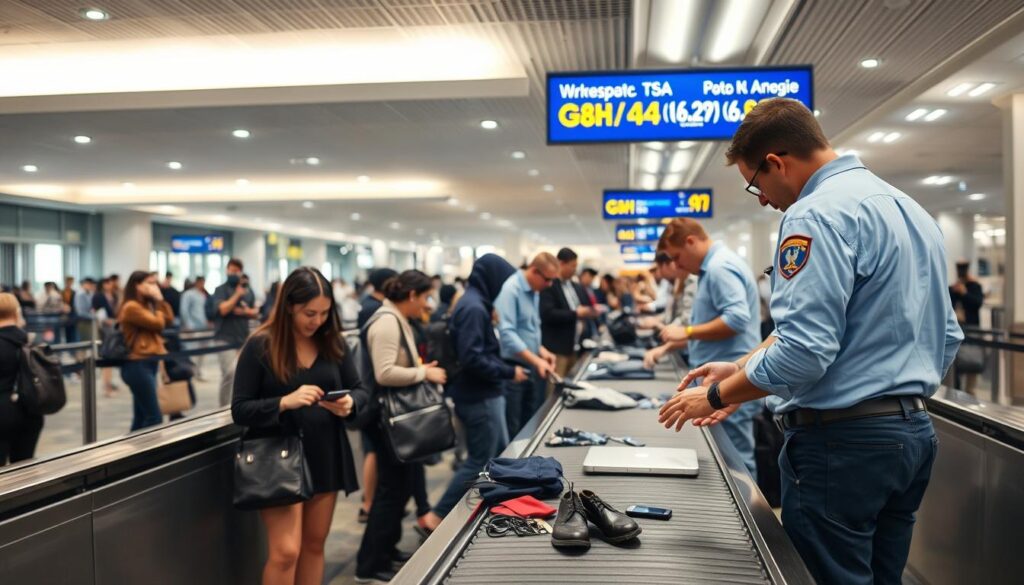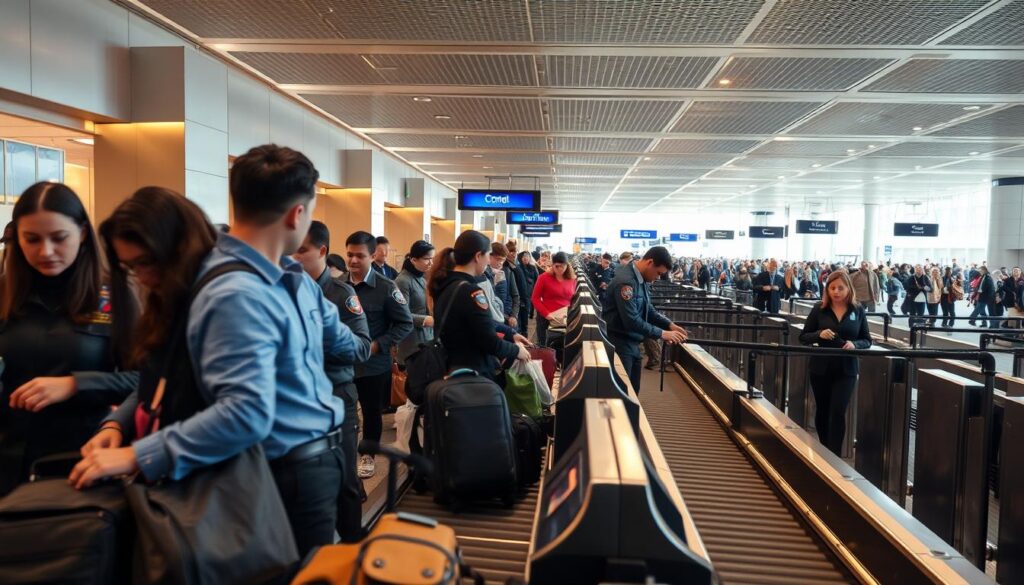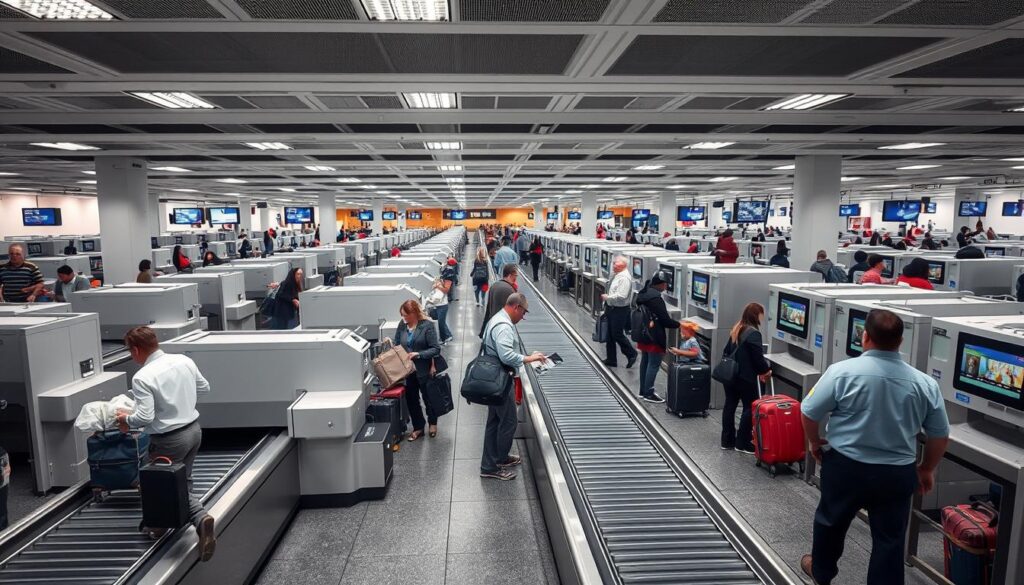What to Expect During Airport Security Screening
Preparing for airport security screening is crucial for a smooth travel experience. The Transportation Security Administration (TSA) provides guidelines to help passengers navigate the process.
Passengers should remove shoes, laptops, and liquids from carry-on bags, as per TSA guidelines. Familiarizing yourself with these security procedures can help avoid issues during screening.
By being prepared, travelers can breeze through security checkpoints, making their overall airport experience more efficient and less stressful.
Preparing for Airport Security
To breeze through airport security, it’s essential to be prepared. One way to do this is by dressing in clothes that are easy to remove and put back on, saving you time during the screening process.
TSA PreCheck is another valuable resource. This expedited screening program allows low-risk travelers to undergo a background check and receive a Known Traveler Number, enabling them to use dedicated security lanes.

Familiarizing yourself with the Transportation Security Administration’s rules on items you can pack is also crucial. Knowing what is allowed and what is prohibited can help you pack accordingly and avoid any issues during screening.
By taking these steps, you can make your airport security experience smoother and less stressful. Being prepared is key to navigating the security checkpoint efficiently.
Understanding the Security Checkpoint Layout
Familiarizing yourself with the security checkpoint layout is essential for a smooth airport experience. The layout can vary from airport to airport, but most follow a similar pattern.
The security checkpoint typically includes several areas: the checkpoint itself, the screening area, and the baggage claim. Understanding the different zones can help you navigate the process more efficiently.
According to TSA guidelines, passengers should be prepared to remove electronics and liquids from their carry-on bags and be ready to pass through security scanners. Knowing what to expect can reduce stress and make the process faster.
By understanding the security checkpoint layout, you can better navigate airport security and reach your gate on time. This knowledge can also help you avoid congestion and long wait times.
What to Expect During Airport Security Screening Procedures
The airport security screening process is designed to ensure safety, and being prepared is key to a hassle-free experience. Passengers should be aware that the Transportation Security Administration (TSA) has specific procedures in place to screen carry-on bags and personal items. Understanding these procedures can help reduce wait times and make the overall process more efficient.

During the TSA screening process, passengers are required to remove certain items from their carry-on bags and place them in separate bins for screening. This includes electronics such as laptops and tablets, as well as liquids and gels.
Removing Electronics and Liquids
To expedite the screening process, it’s crucial to be prepared to remove electronics and liquids from your carry-on bags. Liquids, gels, and aerosols must be in containers of 3.4 ounces or less and fit in a clear, quart-sized zip-top bag. Electronics larger than a cell phone must be removed and placed in a bin for X-ray screening.
By understanding what to expect during the airport security screening procedures, travelers can better prepare themselves for the process, reducing stress and making their journey more enjoyable. Being aware of the requirements for removing electronics and liquids can significantly streamline the screening process.
Navigating Baggage Screening Requirements
To avoid delays or issues during airport security, familiarize yourself with baggage screening requirements. Understanding what is allowed in your carry-on and checked baggage can significantly streamline your airport experience.
Baggage Screening for Carry-On Baggage
Carry-on baggage is subject to specific screening procedures. Ensure that your carry-on bags comply with the Transportation Security Administration’s (TSA) regulations, including the 3-1-1 liquids rule. This means that liquids, gels, and aerosols must be in containers of 3.4 ounces or less, placed in a clear, quart-sized zip-top bag.

Checked baggage also undergoes screening, and certain items are prohibited or require special handling. It’s crucial to pack your checked luggage carefully, avoiding the inclusion of prohibited items such as sharp objects, firearms, and certain types of batteries.
By understanding and adhering to these baggage screening requirements, you can help ensure a smoother security screening process. Always check with your airline or the TSA’s website for the most current information on baggage screening requirements before your trip.
Special Considerations for Different Travelers
Understanding the special considerations for different travelers can significantly reduce stress and make the airport security screening process smoother.
Travelers with medical devices or disabilities may require additional assistance during the security screening process. It is essential for these passengers to notify the security personnel about their condition or device before the screening begins.
Some medical devices, such as pacemakers or prosthetics, may require special screening procedures. Passengers should be prepared to provide information about their device and may be required to undergo additional screening.
Passengers with disabilities can also benefit from advance notification to the airline or security provider. This allows for arrangements to be made to facilitate a smoother screening process.
By understanding the procedures in place for special considerations, travelers can better navigate the airport security screening process, reducing wait times and stress.
Expedited Screening Programs and Time-Saving Options
To save time and make the airport security experience more efficient, consider enrolling in an expedited screening program. Programs like TSA PreCheck and Global Entry are designed to provide a faster and more convenient security screening process for travelers.
TSA PreCheck allows low-risk travelers to undergo expedited security screening without removing shoes, belts, or light jackets. With TSA PreCheck, laptops and compliant liquids can remain in carry-on bags, significantly reducing screening time.
Global Entry is another expedited screening program that not only includes TSA PreCheck benefits but also provides expedited U.S. Customs and Border Protection processing when entering the United States. To enroll, travelers must apply, undergo a background check, and complete an in-person interview.
These programs are ideal for frequent travelers who want to minimize their wait times at airport security checkpoints. By enrolling in expedited screening programs, travelers can enjoy a more streamlined and efficient airport security experience.
Conclusion
Navigating airport security screening can be a daunting task, but being prepared and familiar with TSA guidelines can make a significant difference. By understanding the security checkpoint layout, procedures, and baggage screening requirements, passengers can efficiently move through the airport.
Familiarity with TSA guidelines and security procedures is crucial for a smooth airport security screening experience. Passengers who take the time to understand these guidelines can avoid unnecessary delays and stress. Expedited screening programs, such as TSA Precheck, can also provide a faster and more convenient experience for eligible travelers.
By being informed and prepared, travelers can minimize their wait times and enjoy a more streamlined airport security screening process. Understanding airport security screening procedures and TSA guidelines is key to a hassle-free travel experience.
